Save Our Sacred Sites . . . . STOP the Lancaster Pipeline
For months, Native Americans have been scouring fields in southwestern Lancaster County, Pennsylvania, finding proof of their Native American ancestors who once called it home. Discovered artifacts include pottery shards, stone tools, and beads to name a few. Seven new archaeological sites have been registered with the Pennsylvania Historical and Museum Commission.
Why is this of great concern? Why instead of joy is there anger and anxiety? These sacred grounds have been located along the path of a proposed natural gas pipeline which will take gas to be shipped from Cove Point, Maryland to companies and people overseas. None of the gas will be used for the community. Will all the findings and work make a difference in the ultimate location of the pipeline . . . Who Knows?
August 2014, Williams Partners (Williams), the Oklahoma-based company that will build the Central Penn Line South pipeline, told federal regulators its survey of “cultural resources” along the proposed route was nearly complete. There is, the company acknowledged, a “significant degree of cultural resource sensitivity” in Lancaster County; so the company devoted extra time and scrutiny to investigating the path.
The maps haven’t changed – The route still cuts through several known archaeological sites, including Conestoga Indian Town — perhaps the most important Native American cultural site in Pennsylvania.
Williams officials say the maps will change by the time the company submits its official application to the Federal Energy Regulatory Commission (FERC) in March 2015. Williams will not say exactly how the maps will be revised. Native Americans and their allies are not taking the company’s word for it. Why should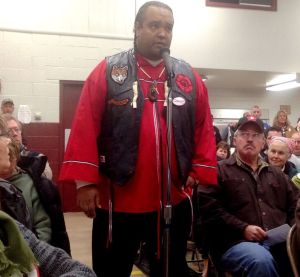 they? What has been the experience of the Native American with companies when it comes to protection of sacred grounds?
they? What has been the experience of the Native American with companies when it comes to protection of sacred grounds?
If all else fails, members of the American Indian Movement (AIM) last week reiterated a vow to block bulldozers to stop the pipeline from being built: “Everyone has been telling [Williams] about how sacred this land is, and it means nothing to them,” said Carlos Whitewolf, a local Native American leader. “We have gotten support from a lot of AIM members, from out-of-state as well,” he said. “When the time comes, we will have some people down here.”
As part of its cultural resource survey, Williams dug at 15-meter intervals along a 300-foot-wide corridor paralleling the proposed path, looking for artifacts. The company has worked closely with the Pennsylvania Museum and Historical Commission; detailed survey reports won’t be publicly available until the company files its application later this year.
Federal law requires pipeline companies to conduct surveys and attempt to go around — even under — any cultural resources they find. In addition to evaluating the route, Williams reached out to 35 Native American tribes, seeking input. But NO ONE reached out to the local Native American opponents of the pipeline – the Native American residents of Lancaster County.
“It would have been nice if Williams had put something in the newspaper, ‘Calling all Native Americans,’ ” said MaryAnn Robins, President of the Circle Legacy Center, a local Native American group. “I have no qualms about going to meet with [the company]. In fact, I challenge them to meet with me.”
In part, the disconnect may be due to the fact that the last of the Susquehannocks, or Conestogas, who once populated this area were killed in the infamous “Conestoga Massacre” of 1783; the tribe no longer exists. But Robins, who traces her lineage to the Onondaga, said Native Americans share a sense of collective history — and outrage when they think it’s being defiled.
The Circle Legacy Center drafted a letter it hopes to have published in Native American newspapers with national circulation, including Indian Country Today and the Native American Times. “We collectively condemn the planning, authorization and construction” of the pipeline, the letter asserts. Of particular concern is the pipeline’s route through “Conestoga Indian Town,” land set aside for the Susquehannocks by William Penn in Manor Township; it is, the letter asserts, “the most significant Native American site in all of Pennsylvania.”
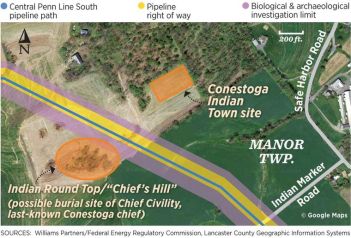 Current maps show the pipeline bisecting it, running between the site where six Susquehannocks were slaughtered during the “Conestoga Massacre” to the northeast, and “Indian Round Top,” which some Native Americans also call “Chief’s Hill.” It may be the burial site of Chief Civility, the last of the Susquehannock chiefs. “Nearly the entire block between Brenneman Road, Safe Harbor Road, Indian Marker Road, and Highville Road was Conestoga Indian Town,” said Darvin Martin, a local historian who has studied the area. “There are certainly graves throughout,” and even if Chief Civility is not buried on Indian Round Top, Martin said it almost certainly was used as a sight tower to send smoke signals north and south.
Current maps show the pipeline bisecting it, running between the site where six Susquehannocks were slaughtered during the “Conestoga Massacre” to the northeast, and “Indian Round Top,” which some Native Americans also call “Chief’s Hill.” It may be the burial site of Chief Civility, the last of the Susquehannock chiefs. “Nearly the entire block between Brenneman Road, Safe Harbor Road, Indian Marker Road, and Highville Road was Conestoga Indian Town,” said Darvin Martin, a local historian who has studied the area. “There are certainly graves throughout,” and even if Chief Civility is not buried on Indian Round Top, Martin said it almost certainly was used as a sight tower to send smoke signals north and south.
MaryAnn Robins is more succinct: “its sacred grounds.”
Opponents of the pipeline are organizing, trying to draw national attention to the cause, reaching out to Hollywood and music industry celebrities they think might be sympathetic. Pipeline opponents have also sent pleas to actor Leonardo DiCaprio, singer Neil Young and ESPN host Keith Olbermann, among others, seeking support. The group also has taken to social media with its “Save Lancaster County’s Sacred Native American Grounds” page. The threats, or promises, to take physical action were reiterated, when Whitewolf told a crowd at a Conestoga Fire Hall pipeline meeting that “We will show up in big numbers, and you will have a war on your hands.” Gene Thunderwolf, another local Native American opponent: “We are not afraid to occupy.”
Robin Maguire says there is no promise the route of the pipeline will change. Williams has long known about Conestoga Indian Town and other culturally sensitive sites along the route. “Six months ago we had a private meeting with Williams,” she said. “We showed them all our findings and they were blown away by what we showed them. Now here we are, looking at these same maps again.” Ms Robins is not willing to bet they’ll change. “There’s so much cultural history around here,” she said. “We can’t let them just erase it away.”
Let’s look at the Susquehannock History.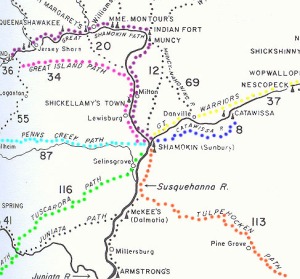
The story begins with Captain John Smith of Jamestown fame, who, while exploring the upper Chesapeake Bay in 1608, had the first recorded European encounter with the native people known as the Susquehannock. That name, as well as the name for the Susquehanna River, is derived from the word Sasquesahanough, a descriptive term used by Smith’s Algonquian interpreter to mean People at the Falls, or People of the Muddy River. Historically, we often come to know tribal groups by the name that others call them, and not what they call themselves. Of course, this trend arises naturally from the fact that most tribes simply call themselves the People, and all others are the Others. How they differentiate among groups of others is how a name becomes attached to a tribe.
In the case of the Susquehannocks, colonial history records numerous names which can be associated with this tribe. The true nature of their society, whether composed of a single tribe in a single village, or a confederacy of smaller tribes occupying scattered villages, will probably never be known, since Europeans seldom visited this inland region during the early colonial period. It’s likely that the Susquehannocks had occupied the same land for several hundred years. What is known is that at the time of the Jamestown settlement in Virginia, the Susquehannocks controlled a vast territory, composed of the Susquehanna River and its tributaries, from what is now New York, across Pennsylvania, to Maryland. They had a formidable village in the lower river valley near present-day Lancaster, Pennsylvania, when Captain Smith met them. He estimated the population of their village to be two thousand, although he never visited it. Modern estimates of their population, including the whole territory in 1600, range as high as seven thousand. But the story of the Susquehannocks has a violent and tragic end. Within a hundred and fifty years, this once powerful tribe was completely obliterated.
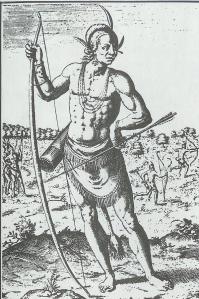 During the 1600′s, the Susquehannocks, like many eastern tribes, were constantly forming alliances and waging wars with their neighbors, both native and European, for control and profit. Historically, the Susquehannocks had always been allies of the Huron and enemies of the Iroquois. During this time they were known to combat other tribes as well, such as the Delaware to the east, the Powhatan to the south, and the Mohawk to the north. Besides control of their native land and its natural trading routes, the Susquehannocks were fighting for the profits of business with the European fur traders. They were perhaps the only tribe to achieve friendly relations with all the Europeans: the French, the Dutch, the Swedes, and the English, at one time or another. They signed treaties with colonial governors of New York, Pennsylvania, Maryland, and Virginia.
During the 1600′s, the Susquehannocks, like many eastern tribes, were constantly forming alliances and waging wars with their neighbors, both native and European, for control and profit. Historically, the Susquehannocks had always been allies of the Huron and enemies of the Iroquois. During this time they were known to combat other tribes as well, such as the Delaware to the east, the Powhatan to the south, and the Mohawk to the north. Besides control of their native land and its natural trading routes, the Susquehannocks were fighting for the profits of business with the European fur traders. They were perhaps the only tribe to achieve friendly relations with all the Europeans: the French, the Dutch, the Swedes, and the English, at one time or another. They signed treaties with colonial governors of New York, Pennsylvania, Maryland, and Virginia.
But the price of constant warfare, along with the ravages of disease, took its toll. As warriors were killed in battle by the hundreds, their numbers quickly declined, and the social structure began to fail. Smallpox epidemics devastated their population at least twice. Many Susquehannocks left their homeland to join other tribes in New York, North Carolina, and Ohio. By the end of the 1600′s, only a few hundred Susquehannocks remained as an identifiable tribe. After migrating as far away as Virginia, they returned to their ancestral home to build a new village, where they lived under the protection of the provincial government of Pennsylvania. Here they were known as the Conestoga, referring to the name of their village, Conestoga Town on the Conestoga River. Some historians have suggested that Conestoga may well have been what the Susquehannock called themselves all along, but the evidence is circumstantial at best.
Conestoga Town quickly became an important center for trade and treaty signings. William Penn himself visited in 1700, as did several succeeding governors of the Commonwealth. Its importance may have been more symbolic than practical, for here was a genuine Indian community, friendly to the colonial settlers, within easy travel distance of the politicians in Philadelphia. The historical record is replete with references to the politicking at Conestoga Town during the first few decades of the 1700′s, but it is remarkably vacant of any meaningful insight into the daily life at Conestoga Town (or even exactly where the town was located!). Although no official censuses were kept, documents of the day suggest that the population of this small, isolated tribe declined steadily, from more than a hundred to a few dozen, within two generations.
The final chapter of the Susquehannocks is well documented in the historical record. In 1763, Chief Pontiac of the Ottawas led uprisings against settlers in the Great Lakes region, including western Pennsylvania. Although the Conestoga were peaceful farmers and craftsman, with no connection to the rebellion in the west, they were attacked by a vigilante group known as the Paxton Boys, who found the Conestoga an easy target. The Paxton Boys murdered the six people they found in the village. The provincial council ordered the rest of the Conestoga to be taken into protective custody, but the measures failed. The Paxton Boys broke into the workhouse and slaughtered all fourteen members of the tribe. Two residents of Conestoga survived the attacked only because they had been away working at another farm. They were a husband and wife known as Michael and Mary. Governor John Penn eventually issued them papers of protection until their death. When they died, the history of the Susquehannocks died with them.
Final Census of the Conestoga, recorded by Lancaster County Sheriff John Hays, 1763
Murdered at Conestoga Town:
• Sheehays • Wa-a-shen (George)
• Tee-Kau-ley (Harry) • Ess-canesh (son of Sheehays)
• Tea-wonsha-i-ong (an old woman) • Kannenquas (a woman)
Murdered at the Lancaster Workhouse:
• Kyunqueagoah (Captain John) • Koweenasee (Betty, his wife)
• Tenseedaagua (Bill Sack) • Kanianguas (Molly, his wife)
• Saquies-hat-tah (John Smith) • Chee-na-wan (Peggy, his wife)
• Quaachow (Little John, Capt John’s son) • Shae-e-kah (Jacob, a boy)
• Ex-undas (Young Sheehays, a boy) • Tong-quas (Chrisly, a boy)
• Hy-ye-naes (Little Peter, a boy) • Ko-qoa-e-un-quas (Molly, a girl)
• Karen-do-uah (a little girl) • Canu-kie-sung (Peggy, a girl)
Survivors on the farm of Christian Hershey:
• Michael • Mary (his wife)
The fate of the Susquehannock was by no means unique. In fact, it was worse for most eastern tribes. In the first few decades of colonial settlement, native peoples who inhabited the coastal regions, including whole tribes, were wiped out at an astonishing rate. Many of their names are lost to history. For the Susquehannock, although the tribe ceased to exist as a consolidated community, their legacy remains with the descendants who survive to embrace their lineage, and with the name that will never be forgotten. As long as the Susquehanna River flows to the sea, we will remember the Susquehannocks.
Our job now is to protect where our Native American ancestors lived and their burial sites from ultimate desecration and destruction by Williams. It is a matter of history, honor, and respect for our Native American ancestors.
~~~Cherokee
2014 in review
The WordPress.com stats helper monkeys prepared a 2014 annual report for this blog.
Here’s an excerpt:
A San Francisco cable car holds 60 people. This blog was viewed about 2,500 times in 2014. If it were a cable car, it would take about 42 trips to carry that many people.
Have We Forgotten Our Heroes? – Chapter 27 – Bray
For many people this article will intensify the conflict regarding women serving in combat roles in the military. However when one reviews the history of wars involving the United States, one will discover many women have served not only in traditional combat roles, also in roles of espionage and infiltration traditionally held by men.
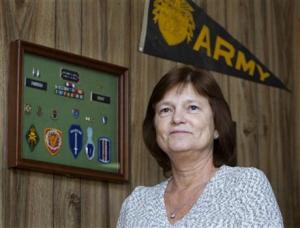 Former U.S. Army Capt. Linda L. Bray says her male superiors were incredulous upon hearing she had ably led a platoon of military police officers through a firefight during the 1989 invasion of Panama. (Operation Just Cause)
Former U.S. Army Capt. Linda L. Bray says her male superiors were incredulous upon hearing she had ably led a platoon of military police officers through a firefight during the 1989 invasion of Panama. (Operation Just Cause)
Instead of being lauded for her actions, the first woman in U.S. history to lead male troops in combat said higher-ranking officers accused her of embellishing accounts of what happened when her platoon bested an elite unit of the Panamanian Defense Force. After her story became public, Congress fiercely debated whether she and other women had any business being on the battlefield.
The Pentagon’s longstanding prohibition against women serving in ground combat ended in 2013, when then-Defense Secretary Leon Panetta announced that most combat roles jobs will now be open to female soldiers and Marines. Panetta said women are integral to the military’s success and will be required to meet the same physical standards as their male colleagues.
“I’m so thrilled, excited. I think it’s absolutely wonderful that our nation’s military is taking steps to help women break the glass ceiling,” said Bray, 54, of Clemmons, N.C. “It’s nothing new now in the military for a woman to be right beside a man in operations.”
The end of the ban on women in combat comes more than 23 years after Bray made national news and stoked intense controversy after her actions in Panama were praised as heroic by Marlin Fitzwater, the spokesman for then-President George H.W. Bush.
Bray and 45 soldiers under her command in the 988th Military Police Company, nearly all of them men, encountered a unit of Panamanian special operations soldiers holed up inside a military barracks and dog kennel.
Her troops killed three of the enemy and took one prisoner before the rest were forced to flee, leaving behind a cache of grenades, assault rifles and thousands of rounds of ammunition, according to Associated Press news reports published at the time. The Americans suffered no casualties. Citing Bray’s performance under fire as an example, Rep. Patricia Schroeder, D-Colo., introduced a bill to repeal the law that barred female U.S. military personnel from serving in combat roles. But the response from the Pentagon brass was less enthusiastic. Schroder’s bill died after top generals lobbied against the measure, saying female soldiers just weren’t up to the physical rigors of combat.
“The responses of my superior officers were very degrading, like, ‘What were you doing there?'” Bray said. “A lot of people couldn’t believe what I had done, or did not want to believe it. Some of them were making excuses, saying that maybe this really didn’t happen the way it came out.”
“The routine carrying of a 120-pound rucksack day in and day out on the nexus of battle between infantrymen is that which is to be avoided and that’s what the current Army policy does,” Gen. M.R. Thurman, then the head of the U.S. Southern Command, testified before the Senate Armed Services Committee.
For Bray, the blowback got personal.
The Army refused to grant her and other female soldiers who fought on the ground in Panama the Combat Infantryman Badge. She was awarded the Army Commendation Medal for Valor, an award for meritorious achievement in a non-combat role.
Bray was also the subject of an Army investigation over allegations by Panamanian officials that she and her soldiers had destroyed government and personal property during the invasion that toppled Panamanian dictator Manuel Noriega.
Though eventually cleared of any wrongdoing, the experience soured Bray on the Army. In 1991, she resigned her commission after eight years of active duty and took a medical discharge related to a training injury.
Today’s military is much different from the one Bray knew, with women already serving as fighter pilots, aboard submarines and as field supervisors in war zones. But some can’t help but feel that few know of their contributions, said Alma Felix, 27, a former Army specialist.
“We are the support. Those are the positions we fill and that’s a big deal — we often run the show — but people don’t see that,” Felix said. “Maybe it will put more females forward and give people a sense there are women out there fighting for our country. It’s not just your typical poster boy, GI Joes doing it.”
(Information for this article was gathered from newspapers, military documents and interviews)
Advent – Christmas Eve
 On Christmas Eve, the white center candle is traditionally lit. This candle is called the “Christ Candle” and represents the life of Christ that has come into the world. The color white represents purity. Christ is the sinless, spotless, pure Savior. Also, those who receive Christ as Savior are washed of their sins and made whiter than snow.
On Christmas Eve, the white center candle is traditionally lit. This candle is called the “Christ Candle” and represents the life of Christ that has come into the world. The color white represents purity. Christ is the sinless, spotless, pure Savior. Also, those who receive Christ as Savior are washed of their sins and made whiter than snow.
Let’s look at our scripture passages for Christmas Eve beginning with the letter to Titus, Titus 2:11-15 (NASB) . . .
11 For the grace of God has appeared, bringing salvation to all men,
12 instructing us to deny ungodliness and worldly desires and to live sensibly, righteously and godly in the present age,
13 looking for the blessed hope and the appearing of the glory of our great God and Savior, Christ Jesus,
14 who gave Himself for us to redeem us from every lawless deed, and to purify for Himself a people for His own possession, zealous for good deeds.
15 These things speak and exhort and reprove with all authority. Let no one disregard you.
Our Second passage is from the gospel according to Luke . . . Luke 2:1-14(NASB) . . . .
1 Now in those days a decree went out from Caesar Augustus, that a census be taken of all the inhabited earth.
2 This was the first census taken while Quirinius was governor of Syria.
3 And everyone was on his way to register for the census, each to his own city.
4 Joseph also went up from Galilee, from the city of Nazareth, to Judea, to the city of David which is called Bethlehem, because he was of the house and family of David,
5 in order to register along with Mary, who was engaged to him, and was with child.
6 While they were there, the days were completed for her to give birth.
7 And she gave birth to her firstborn son; and she wrapped Him in cloths, and laid Him in a manger, because there was no room for them in the inn.
8 In the same region there were some shepherds staying out in the fields and keeping watch over their flock by night.
9 And an angel of the Lord suddenly stood before them, and the glory of the Lord shone around them; and they were terribly frightened.
10 But the angel said to them, “Do not be afraid; for behold, I bring you good news of great joy which will be for all the people;
11 for today in the city of David there has been born for you a Savior, who is Christ the Lord.
12 This will be a sign for you: you will find a baby wrapped in cloths and lying in a manger.”
13 And suddenly there appeared with the angel a multitude of the heavenly host praising God and saying,
14 “Glory to God in the highest, And on earth peace among men with whom He is pleased.”
Tonight all candles are lit starting with the “Prophecy Candle” (purple), then the “Bethlehem Candle” (purple), Next is the “Shepherds’ Candle” (rose), then the “Angels’ Candle” (purple) and tonight the “Christ Candle” (white).
Let us pray . . . Father unto You be glory, honor and power, joy, peace, love and purity for only You have given us Christ the Lord Who is King and Shepherd, Savior and Lord. We thank You for Your graciousness and love, for the amazing sacrifice You make, in Jesus’ precious name, Amen.
The Fourth Sunday of Advent
 The fourth and last Sunday of Advent is for the celebration and representation of Peace. Let’s read our scripture passages, the first being from the first letter to the church of Corinth. 1 Corinthians 4:1-5 (NASB)
The fourth and last Sunday of Advent is for the celebration and representation of Peace. Let’s read our scripture passages, the first being from the first letter to the church of Corinth. 1 Corinthians 4:1-5 (NASB)
4 Let a man regard us in this manner, as servants of Christ and stewards of the mysteries of God.
2 In this case, moreover, it is required of stewards that one be found trustworthy.
3 But to me it is a very small thing that I may be examined by you, or by any human court; in fact, I do not even examine myself.
4 For I am conscious of nothing against myself, yet I am not by this acquitted; but the one who examines me is the Lord.
5 Therefore do not go on passing judgment before the time, but wait until the Lord comes who will both bring to light the things hidden in the darkness and disclose the motives of men’s hearts; and then each man’s praise will come to him from God.
Our second passage of scripture comes from the gospel according to Luke Chapter 3, verses 1-6 (NASB) . . . .
3 Now in the fifteenth year of the reign of Tiberius Caesar, when Pontius Pilate was governor of Judea, and Herod was tetrarch of Galilee, and his brother Philip was tetrarch of the region of Ituraea and Trachonitis, and Lysanias was tetrarch of Abilene,
2 in the high priesthood of Annas and Caiaphas, the word of God came to John, the son of Zacharias, in the wilderness.
3 And he came into all the district around the Jordan, preaching a baptism of repentance for the forgiveness of sins;
4 as it is written in the book of the words of Isaiah the prophet,
“The voice of one crying in the wilderness,
‘Make ready the way of the Lord,
Make His paths straight.
5‘Every ravine will be filled,
And every mountain and hill will be brought low;
The crooked will become straight,
And the rough roads smooth;
6And all flesh will see the salvation of God.’”
Today we light four candles, the “Prophecy Candle” (purple), the “Bethlehem Candle” (purple), the “Shepherd’s Candle” (rose) and the fourth and last purple candle, oftentimes called the “Angels Candle,” represents peace.
Let us pray, Father we thank You for bringing us through this time of preparation to receive Your Son, our Lord and Savior. What a magnificent gift You have given and are giving us when He returns to gather His brothers and sisters, Your children, Home to glory. Keep us ever mindful of the price You paid when He came to earth in human form, totally human, yet totally divine, in His precious name we pray, Amen.
The Third Sunday of Advent
 On the third Sunday of Advent we concentrate on joy. Lets look at our scripture passages. The first one in from the letter to the church at Philippi, Philippians 4:4-7 (NASB) . . .
On the third Sunday of Advent we concentrate on joy. Lets look at our scripture passages. The first one in from the letter to the church at Philippi, Philippians 4:4-7 (NASB) . . .
4 Rejoice in the Lord always; again I will say, rejoice!
5 Let your gentle spirit be known to all men. The Lord is near.
6 Be anxious for nothing, but in everything by prayer and supplication with thanksgiving let your requests be made known to God.
7 And the peace of God, which surpasses all comprehension, will guard your hearts and your minds in Christ Jesus.
Our second scripture passage is from the gospel of John 1:19-28 (NASB)
19 This is the testimony of John, when the Jews sent to him priests and Levites from Jerusalem to ask him, “Who are you?”
20 And he confessed and did not deny, but confessed, “I am not the Christ.”
21 They asked him, “What then? Are you Elijah?” And he *said, “I am not.” “Are you the Prophet?” And he answered, “No.”
22 Then they said to him, “Who are you, so that we may give an answer to those who sent us? What do you say about yourself?”
23 He said, “I am a voice of one crying in the wilderness, ‘Make straight the way of the Lord,’ as Isaiah the prophet said.”
24 Now they had been sent from the Pharisees.
They asked him, and said to him, “Why then are you baptizing, if you are not the Christ, nor Elijah, nor the Prophet?”
26 John answered them saying, “I baptize in water, but among you stands One whom you do not know.
It is He who comes after me, the thong of whose sandal I am not worthy to untie.”
These things took place in Bethany beyond the Jordan, where John was baptizing.
On the third Sunday of Advent the pink, or rose-colored candle is lit. This pink candle is customarily called the “Shepherds Candle” and it represents joy. Today we light three candles, the “Prophecy Candle” (purple); the “Bethlehem Candle” (purple) and todays is the pink or rose candle know as the “Shepherd’s Candle.”
Let us Pray . . . Father thank You for giving us time to prepare for the coming of Your Son. As we look forward to His birth, we also look forward to His coming again and thank You for our redemption through Christ our Lord, Amen.
The Second Sunday of Advent
 On the second Sunday of Advent, the second purple candle is lit. This candle typically represents love. Some traditions call this the “Bethlehem Candle,” symbolizing Christ’s manger. As we begin our Celebration of the Second Sunday of Advent, let’s join together and read from the letter to the Romans, chapter 15, verses 4-13 (NASB) . . .
On the second Sunday of Advent, the second purple candle is lit. This candle typically represents love. Some traditions call this the “Bethlehem Candle,” symbolizing Christ’s manger. As we begin our Celebration of the Second Sunday of Advent, let’s join together and read from the letter to the Romans, chapter 15, verses 4-13 (NASB) . . .
4 For whatever was written in earlier times was written for our instruction, so that through perseverance and the encouragement of the Scriptures we might have hope.
5 Now may the God who gives perseverance and encouragement grant you to be of the same mind with one another according to Christ Jesus,
6 so that with one accord you may with one voice glorify the God and Father of our Lord Jesus Christ.
7 Therefore, accept one another, just as Christ also accepted us to the glory of God.
8 For I say that Christ has become a servant to the circumcision on behalf of the truth of God to confirm the promises given to the fathers,
9 and for the Gentiles to glorify God for His mercy; as it is written,“Therefore I will give praise to You among the Gentiles,
And I will sing to Your name.”10 Again he says,
“Rejoice, O Gentiles, with His people.”
11 And again,
“Praise the Lord all you Gentiles,
And let all the peoples praise Him.”12 Again Isaiah says,
“There shall come the root of Jesse,
And He who arises to rule over the Gentiles,
In Him shall the Gentiles hope.”13 Now may the God of hope fill you with all joy and peace in believing, so that you will abound in hope by the power of the Holy Spirit.
Lets now read together from the gospel of Matthew. Matthew 11:2-10 (NASB)
2 Now when John, while imprisoned, heard of the works of Christ, he sent word by his disciples
3 and said to Him, “Are You the Expected One, or shall we look for someone else?”
4 Jesus answered and said to them, “Go and report to John what you hear and see:
5 the blind receive sight and the lame walk, the lepers are cleansed and the deaf hear, the dead are raised up, and the gospel preached to them.
6 And blessed is he who does not take offense at Me.”
7 As these men were going away, Jesus began to speak to the crowds about John, “What did you go out into the wilderness to see? A reed shaken by the wind?
Advent-wreath-wk2-m8 But what did you go out to see? A man dressed in soft clothing? Those who wear soft clothing are in kings’ palaces!
9 But what did you go out to see? A prophet? Yes, I tell you, and one who is more than a prophet.
This is the one about whom it is written, ‘Behold, I send My messenger Who will prepare Your way before You.’
Now let’s light the “Prophecy Candle” from week one and now the “Bethlehem Candle” for this week.
Let’s pray, Father we thank You for Who You are and for all the ways You show us Your love. Through the Prophets of old You gave us a promise and we see You have fulfilled it. We can therefore learn from this that Your word is tried and true. You will always keep Your promises. Thank You for showing us Your love as we prepare for the birth of our Lord, in Jesus’ name, Amen.
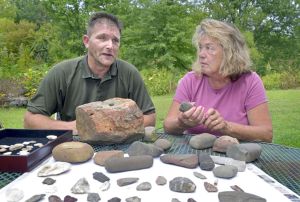

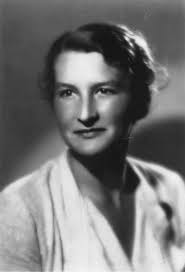
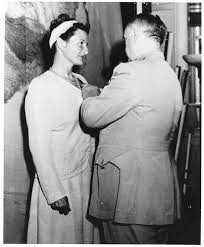
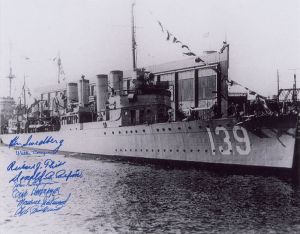 beginning of World War II, Captain William Outerbridge skippered the USS Ward, a re-commissioned ship built during the World War I period. Reportedly in his first command and on his first patrol off Pearl Harbor, Hawaii, on December 7, 1941, Outerbridge
beginning of World War II, Captain William Outerbridge skippered the USS Ward, a re-commissioned ship built during the World War I period. Reportedly in his first command and on his first patrol off Pearl Harbor, Hawaii, on December 7, 1941, Outerbridge and the USS Ward detected a Japanese two-man midget submarine near the entrance to Pearl Harbor. The USS Ward detected the midget sub at 6:45 AM and sank it at 6:54 AM, firing the first shots in defense of the U.S. in World War II. Captain Outerbridge was reportedly awarded the Navy Cross for Heroism.
and the USS Ward detected a Japanese two-man midget submarine near the entrance to Pearl Harbor. The USS Ward detected the midget sub at 6:45 AM and sank it at 6:54 AM, firing the first shots in defense of the U.S. in World War II. Captain Outerbridge was reportedly awarded the Navy Cross for Heroism.
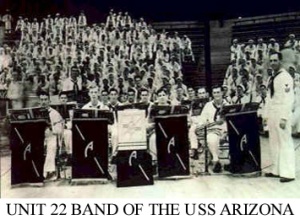


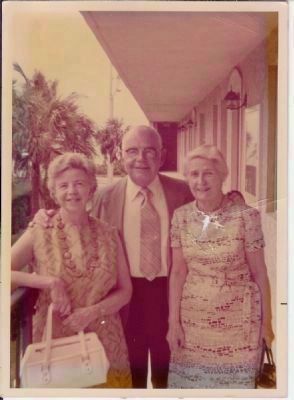
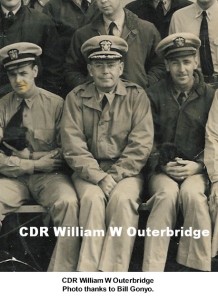
![Advent+-+First+Sunday-003[1]](https://caseymac1944.files.wordpress.com/2014/08/advent-firstsunday-0031.jpg?w=620)


Recent Comments